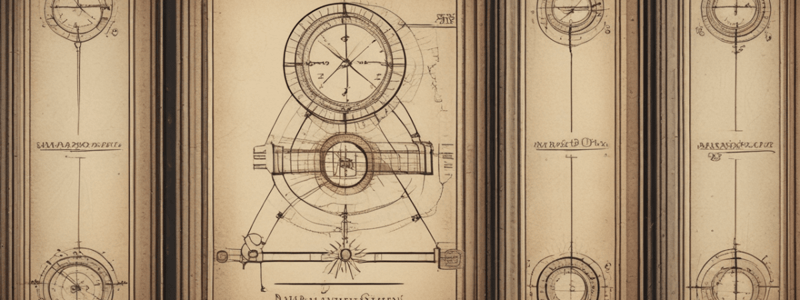Podcast
Questions and Answers
What is the conversion factor from meters to kilometers?
What is the conversion factor from meters to kilometers?
- 1 kilometer per 1,000 meters (correct)
- 1 meter per 1 kilometer
- 1 kilometer per 100 meters
- 1,000 kilometers per meter
When setting up an equation, why must the units of the ingredients be on the opposite side of the fraction bar from the conversion factor?
When setting up an equation, why must the units of the ingredients be on the opposite side of the fraction bar from the conversion factor?
- So that the units cancel out (correct)
- So that the units are combined
- So that the numbers are multiplied together
- So that the units are added together
What is the purpose of the number 1 in the denominator in the equation (2,000 m / 1) * (1 km / 1,000 m) = km?
What is the purpose of the number 1 in the denominator in the equation (2,000 m / 1) * (1 km / 1,000 m) = km?
- It has no effect on the math (correct)
- It is a placeholder to balance the equation
- It is a multiplier to increase the answer
- It is a conversion factor
What is the unit of the answer when converting 1.5 kilograms to grams using the conversion factor 1,000 grams per kilogram?
What is the unit of the answer when converting 1.5 kilograms to grams using the conversion factor 1,000 grams per kilogram?
What is the conversion factor used to convert milliliters to liters?
What is the conversion factor used to convert milliliters to liters?
What is the analogy used to explain the process of converting units in the metric system?
What is the analogy used to explain the process of converting units in the metric system?
What is the role of the conversion factor in the metric system conversion process?
What is the role of the conversion factor in the metric system conversion process?
What is the relationship between a metric unit's name and its value?
What is the relationship between a metric unit's name and its value?
What is the conversion factor in the example problem of converting 2,000 meters into kilometers?
What is the conversion factor in the example problem of converting 2,000 meters into kilometers?
Where can you find a conversion factor when working on conversion problems?
Where can you find a conversion factor when working on conversion problems?
Flashcards are hidden until you start studying
Study Notes
Converting Units in the Metric System
- The process of converting units in the metric system involves three key elements: the basic ingredients (what you're starting with), the smoothie (what you want to end up with), and the blender (the conversion factor).
- The conversion factor is essential to the process and helps convert the ingredients into the final product.
Setting Up the Conversion
- To set up a conversion, identify the starting unit (basic ingredients), the desired unit (smoothie), and the conversion factor (blender).
- The conversion factor can be found online or in a textbook, or can be derived from understanding the relationship between a metric unit's name and its value.
Calculating the Conversion
- When setting up an equation, always put the ingredients first, followed by the conversion factor, and then the desired unit (smoothie).
- The units of the ingredients must always be on the opposite side of the fraction bar to cancel out.
- Ensure that the units being cancelled out are on opposite sides of the fraction bar.
Examples and Practice
- Convert 2,000 meters to kilometers: (2,000 m / 1) * (1 km / 1,000 m) = km
- Convert 1.5 kilograms to grams: (1.5 kg / 1) * (1,000 g / 1 kg) = g
- Convert 13,000 milliliters to liters: (13,000 mL / 1) * (1 L / 1,000 mL) = L
Studying That Suits You
Use AI to generate personalized quizzes and flashcards to suit your learning preferences.




